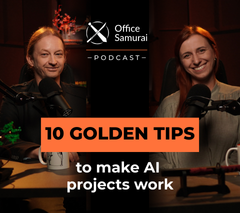Introduction: The digital camera inside your operations
AK: Konnichiwa welcome to the AI Automation Dojo, the show for anyone who’s ever starred at a corporate process and thought, “This can’t be the result of intelligent design, can it?”. A while back, I told you all about task mining – the technology that acts like a camera inside your operations. Today we’re talking to the guy who built that camera. We have the co-founder and CEO of our favorite productivity intelligence platform, KYP.ai, Adam Bujak.
I’m your host Andrzej Kinastowski, one of the founders of Office Samurai. We believe the most expensive thing in business is a beautiful process map that has zero connection to reality. So whether you’re a manager who feels like you’re flying blind, an employee drowning in nonsensical workarounds, or just someone who loves a good story about how data triumphs over delusion, you’re in the right place. Now grab your favorite katana or that letter of resignation you’ve been writing since 2019, and let’s get to it.
I met Adam something like 15 years ago. We actually met in Bangalore, India, where he was managing operations for the BPO for Asia-Pacific at the time. I was quite amazed by the amount of time and attention Adam was willing to give me. Sometime later, Adam came back from India and he took over the global delivery excellence organization. He has become the boss of my boss’s boss and we had great cooperation. When I left Capgemini, we kind of lost touch. Four years ago I saw on LinkedIn that Adam is doing something really interesting, so I reached out. We started talking and our company started cooperating.
AB: Thank you for having me.
AK: I wanted to start with asking you about the name of the company, KYP.ai, which you guys translate to “know your process,” “know your people,” “know your potential.” It is quite clever, and I wanted to ask you, is this something that you started with, or did you have some early horrible names that you were rolling with before this one came up?
The origin story: From KYC to KYP.ai
AB: Actually, we thought the name should be simple, playing off KYC (Know Your Customer) that everybody knows. We said nobody is using KYP so we go for it. At that time it was “know your process potential,” and this P was in a square, so we said P-square. Nobody understood it, of course, so it’s a funny story. Actually, our logo was drawn for the first time in one of the restaurants in Krakow on a handkerchief. We’re very proud of it, so one can say that the company was born here in Krakow.
AK: Yeah, that sounds good. The best things it seems are born drawn on a handkerchief. Before founding KYP.ai, you spent 14 years in the same big international corporation. I know it from my experience it can get cozy, especially once you reach a certain level, and you have a nice career. Tell me, how did it happen that you said, “I don’t need this nice monthly paycheck anymore. I’m going to start my own business?”.
The decision to leave the corporate world
AB: I was an entrepreneur before I came to Capgemini. I knew before I joined Capgemini that I will leave after 10 years. I came to learn how big corporations cook their meals, basically. There was a mission, and I go for 10 years. I had absolutely no expectations in terms of a great career, becoming a big leader, or whatsoever. I was just open to learn. What my boss did not know was that the salary – a lousy salary, by the way – that they paid me was earned in 5 days in my career before Capgemini. I was ready to learn; that was the mission. I always have a next step in my mind.
AK: What was the reaction of people around you when you said, “I’m leaving the corporate world to build something of my own?”.

AB: First of all, there is a big echo that you may create in organizations like that, especially when you’re exceptionally successful. I was successful because I had great bosses; I had fantastic employees that worked with me. When I got to the executive committee, you have a fantastic car, you have pension plans, you have shares. It spoiled dramatically, but I knew I have to go. We were already building the solution; we ran out of money basically. We could not pay the eight developers that we had, so we had to acquire some VC money. When you acquire VC money, you sign a notary deal, so there is no way back.
I tell you that there was a misleading experience I had when I announced that I’m leaving. I got 4,000 plus likes, hundreds of comments, people congratulating me on this move, and I was so proud. My ego was absolutely on top of Everest. And then my third post about KYP.ai got 12 likes. I knew something went wrong. I met one of my colleagues from that time two years ago, and when she got drunk, she told me, “Adam, we thought you’re an absolute idiot because nobody drops a career, a job where you can easily retire.” I was owning global intelligent automation practice; I was defining the trajectory of Capgemini.
AK: Did you ever doubt it was the right move?
AB: Actually, every second day in these initial moments of your journey, you’re looking into the mirror and you say, “I have two children, I have a wife who is fantastic enabler of everything that I have achieved. Do they deserve another journey?”. My wife delivered her first baby when we were in India. I’m giving them a roller coaster. At that time, every second day I looked at the mirror and I questioned, “Am I an absolute idiot, or maybe it will succeed?”. I would finish with one statement: Don’t do it. If you like stability, you can plan your holidays and retirement, just don’t do it. It’s not for everyone.
AK: I am really happy I did it, but it’s clearly not for everyone. It requires a lot of you and it is a big burden on yourself, on the family, and so on, for sure. Why was the idea behind KYP.ai the one thing that you took the next step with?
The purpose of KYP.ai: Data over gut feeling
AB: At that time, we were deploying primarily robotic process automation for our global clients as Capgemini. I saw two inherent problems:
- Although we had 280 business analysts, we were not always picking the best use cases. For instance, a controller or finance team looking at the investment they put (usually a few millions in the game to deploy something), and then 80k savings realized was not a good ROI for anybody. We said we have to somehow figure that out.
- Because the delivery excellence job was about analyzing processes, streamlining, eliminating waste, standardization, I knew that the process complexity is a little bit more than just drawing on the board. We said we need technology to embrace that.
When you’re working for giants like Capgemini, they are not ready to shell out funds to build big software solutions. They are in the service business. So we had to go out and create something externally.
AK: So you basically thought, “If I cannot do it within the company, I’m going to have to do it outside”.

AB: We decided you can’t abandon these eight people that you have hired. Your pockets are empty, so it’s either now or…
AK: For anyone who never heard about KYP.ai, in simple words, what is the benefit companies get from implementing it?
AB: Good night sleep. Leaders have a problem of using their gut feeling too frequently. What we like is being data-driven. Whether you steer operations, whether you drive change, you need data. That makes the whole story much simpler because the decision-making process is far easier. You’re using Google Maps or Waze, and you know, “I need to go for 500 kilometers. I’m planning to reach there tonight. I need a certain amount of fuel. This is the optimal path.” And we’re trying to find this optimal path. We ultimately deliver life information at scale. In three sentences: First of all, see what’s happening. Understand the details. And then change to generate the outcome.
The brutal truth: Leaders flying blind
AK: The software delivers truth about what’s going on in the processes, and sometimes this truth is quite brutal to people. What is the one thing that the leaders and managers get wrong about what’s happening inside their teams?
AB: I would just share what I learned. I knew that the process reality is a little bit more complex than what a human brain can embrace. But what surprised me the most is that a low performer in an organization in a transactional environment executes up to 17,000 actions a day. The top performer goes to 35,000. What does it mean? It means that our human brain is incapable of embracing it.
I feel sorry for all the leaders. If you’re not equipped with objective information on what’s happening and what can you change, it’s a very difficult job. It’s like if I would ask you now, “Walk to the capital of Kazakhstan. Good luck.” And you are supposed to tell me when, without a mobile phone, without the maps, etc. I have a strong feeling that lots of leaders are facing this challenge: walk to Kazakhstan’s capital from Krakow without instruments that help them to be successful. I think this is paramount, especially now in the era of data. It’s all available; it’s there.

AK: I always felt like when I was doing lean management projects, we saw that there’s so many misconceptions about what’s really happening. It was almost impossible for leaders and managers to really understand what their people are doing unless it was something really simple.
Surprising discoveries from task mining
AK: Do you have any examples of things that KYP.ai helped companies find in their processes that were really surprising for them?
AB: Three examples:
- The army of high-performing introverts: There’s a huge army of high-performing introverts on this planet that are absolutely underestimated because they never shout about their contributions. They are silent executors, usually supporting multiple parties. For us, there’s a very rewarding moment where we can demonstrate how complex things are. Nobody nowadays in the hybrid environment sees the army of high-performing introverts working after midnight and then burning out. That’s what we try to enable – the visibility of the contribution.
- Wasting money on RPA: Lots of people are taking wrong decisions because of lack of data. When we are showing, for instance, that robotic process automation is absolutely useless, people open their eyes. It has nothing to do with the greatness of RPA; the technology works. But when you have 1 million variants and everything is done differently, and you contracted at the wrong price, the license is just too expensive to continue the replacement. How do I waste money on things that I, from my managerial perspective, see as relevant, but my employees would never execute on? The 17,000 actions or 35,000 actions – this is inhuman.
- Derisking GenAI: People are talking now about AI agents. KYP.ai is enabling not only to find the best use cases but also to build the code for this agent and calculate the business case up front based on data, on reality. Building an AI agentic story is like going to the moon. We see ourselves as the enabler to succeed, to derisk it.

Generative AI, adoption, and context
AK: You touched upon GenAI, which is all the hype right now. Do you consider generative AI something that will actually be a game-changer when it comes to business processes, or do you consider it more of a distraction from the core problems that we’ve had for decades?
AB: Neither nor. Time will tell. When Mira, our CTO, told me that he’s going to apply Open AI to a process graph, I said, “What’s the value of it?”. What we saw coming out of the data points that we are uploading is absolutely exceeding all expectations that I had.
Now you can prompt with KYP.ai or organization. We have leadership prompts which basically tell you, “Hey, appreciate this team because they did an exceptional job yesterday,” or it tells an employee, “Look, you’re working so hard. It has been two and a half hours of work yesterday, which we noticed, and you should actually probably do some situps.” We are equipping you with what you need to succeed, depending on the level, because we are trying to address both top leadership as well as individual employee.
I believe it’s about adoption. It’s not about being equipped with all these copilots. It’s about how you structure this journey for people that may not be as obsessed with these technologies as hungry as we are on a daily basis, and still give them an opportunity to benefit from it. For most sophisticated users, we are enabling everybody to prompt with KYP.ai, but you can also define two pages long prompts that are just clickable through a pathway. The employee or a team leader doesn’t need to code to understand the complexity. The potential is unquestionable, but we’ve seen that there’s plenty of amazing technologies that are utilized at 5 to 10%. I think that’s the challenge.
AK: If you don’t have people who are able to understand data and know at least what questions to ask, the data is worthless.
AB: I would add a context to it. We both can have access to Gemini or whatever the solution is, but the question is, what kind of data is it analyzing? What’s the reference point? I think understanding the context is critical. That’s why we are also very happy that we’re producing this data or helping to uncover the structured and unstructured data components to enable prompting that is targeted at the problems that are existing in a given specific organization, in a department, in the process.
Addressing the “big brother” factor (privacy and trust)
AK: A big part of this technology is the understanding of what people are doing on their computers. For a lot of people, the first time we talk about these kinds of technologies, a lot of people get this kind of “big brother” feeling. How do you approach this human privacy and human feelings of being observed? How do you talk to people about this making sense for them as employees?

AB: First of all, we wanted to be a privacy-first company, meaning you only need as much data as is required to achieve something. The objective maybe I want to improve my performance or I want to do less transactional work and use my knowledge. We see this as an enabler. At the beginning, you are deciding what will be whitelisted. Maybe you want to understand where copy-paste happens most frequently, jumping between SAP and Excel. This observability is essential on the how, but not necessarily checking whether someone arrives at 9 or leaves on time. The point is the how things are done, how things can be changed. It provides a navigation point – like knowing there’s a traffic jam or how much fuel your car is consuming.
It’s like I go to the doctor and they say, “Hey, you have high blood pressure.” You know that they are going to use it for your own good. I’d like to prevent the high blood pressure. The discussion with the doctor is not about how can you heal me out of this disaster, but how can I prevent this situation from happening. We see lots of illnesses in every organization. Preventing it from happening is the most critical one.
AK: And for your doctor to keep you healthy, you need to do your checkups regularly and you need to measure the parameters of your body so they know what to do with you, plus you need to live your life reasonably.
AB: What people learn is that the older I’m getting, the more exciting it gets, because I have to work every moment on increasing the chances of surviving the next 10 years. I rather have in mind how you can navigate this whole complexity in a healthy manner. You want to start doing prevention instead of firefighting so you measure early before you get into a major trouble.
Advice for leaders: Start with yourself
AK: When you think about leaders who think about how to lead in a better way or transform what we are doing before we are forced to, what would be your advice to them?
AB: I don’t feel entitled to advise anyone, but if you will turn the story and say what could you tell to yourself, I would say start with yourself first. It’s not about the others that are penalizing you every day; it’s about you becoming a role model and embracing this challenge, educating yourself, challenging yourself.
Number two: I would say you have to respect the fact that it’s also people that play a vital role in it. Technologies will not replace good change management or understanding that someone may not be in the best fit today, that someone may have worries about what’s happening.
Number three: I love the flow concept. There’s a professor at the Harvard University, Chik Chin Mihili, and he developed the concept of flow. You always have to match the challenge with capabilities. If there’s too much challenge and low capabilities, people are in stress (burnout situation). When there’s too much capabilities and not enough challenge, there’s a boring out, which is equally stressful. How to maintain the flow? When they are in the flow state, this is when they make the most miracles.
AK: I’m also a big fan of the flow concept, which is, you need to beware not to overburden them with too much of a challenge, but also not to let them be bored for too long.
AB: Coming back to KYP.ai, my obsession is to deliver value. We are equipped with a very innovative team. We’re trying to think through ahead of time what the lessons learned from our private lives in terms of large language models, prompting, etc., may mean for a corporate world. We see that technology plays there an essential role as long as you’re helping to navigate the best use of it. We recently saw a customer achieve an ROI of 4,000%, which is unbelievable. When you add value, people smile at you and say, “Hey, we navigated it together”.
AK: Lovely Adam, thank you so much for joining us. I’m really eager to see what’s going to be happening in the near future and I’m really looking forward to our continued cooperation.
AB: Thank you so much for having me.
AK: And that’s a wrap on the origin story of KYP.ai. It seems the recipe for innovation is one part observation, one part frustration, and two parts courage to actually do something about it. Dōmo arigatō for tuning in. A massive thank you to our guest Adam Bujak. This episode would be a glorious mess without the steady hand of Anna Cubal, our producer. We record at the mighty Wodzu Beats Studio. Until next time, stop guessing what the problem is and go find the data.




